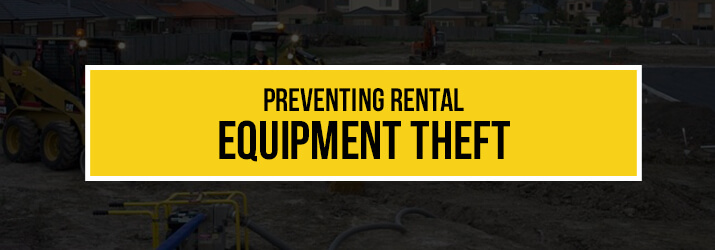
Equipment theft creates several problems for hard workers in rugged industries. Missing rentals result in lost time, money and effort that could be used instead to get the job done. However, with the right resources and awareness, you can reduce the risk of rental equipment theft and react quickly if it happens. In this guide, we’ll address:
- Why and how often rental equipment theft occurs
- What rental theft can cost you
- How to react when theft happens
- How to lower your risk of equipment theft
We hope you will refer to this guide to help you look after your rentals. Read on for all the information you need on construction equipment theft and prevention.
Jump to Sections:
- Equipment Theft in Indiana, Michigan and Beyond
- Why Does Rental Equipment Get Stolen?
- How Much Does Missing Equipment Cost?
- What to Do If Your Rental Goes Missing
- Preventing Equipment Theft
- Theft-Deterrent Technology for Construction Equipment and Other Rentals
- Investing in Rental Equipment Insurance
Equipment Theft in Indiana, Michigan and Beyond
According to the National Equipment Register’s (NER) 2016 equipment theft report, the most frequently occurring equipment risk in the United States is theft. Equipment theft becomes more common in regions where people use such equipment more frequently. Think areas with large agriculture and construction industries. Once equipment gets stolen, only 21% of it is recovered.
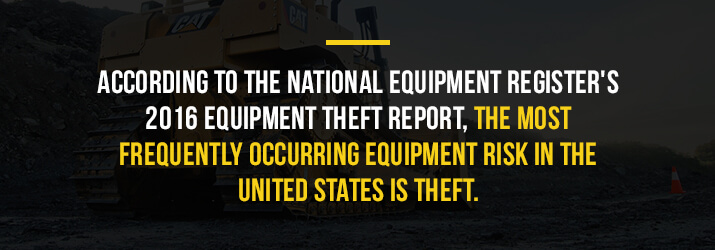
Our service area has experienced higher-than-average rates of heavy equipment theft in past years. While Indiana didn’t make the 2016 report’s list of the top ten states for equipment theft, it ranked 9th the previous year. On the other hand, it had the 9th highest rate of recovery in 2016, with 74 machines recovered. The report didn’t mention Michigan, but news reports suggest rural areas faced high rates of theft in 2016.
Why Does Rental Equipment Get Stolen?
Heavy equipment, whether rented or owned, is coveted by many thieves. They can earn an average of about $29,000 for every piece they steal, making heavy equipment very profitable for criminals. Newer equipment has an even higher chance of being stolen because of its value. A piece of equipment’s year of manufacture directly corresponds to the number of thefts.
Rental equipment has an even higher risk of theft than owned equipment, and it makes up 30% of all construction equipment in the United States. Due to changes in tax-credit laws the 1980s, many contractors find it more cost-effective to rent instead of buy. That affordability caused rental rates to soar throughout recent years. These numbers make nearly a third of common heavy equipment vulnerable to theft. Stolen machinery is an issue that impacts a large part of the construction industry and other hands-on professions.
Thieves often have more opportunities to steal rental equipment than they do owned machinery. Renters tend to put fewer security measures in place on their equipment because they don’t plan to have it for a long time. Even renters who do want extra security may not have the budget to afford it for a short-term rental. Since rental machinery is constantly transported between worksites and dealerships, thieves have plenty of opportunities compared to equipment kept in one location.
How Much Does Missing Equipment Cost?
Hardworking people in many industries lose millions of dollars every year because of this issue. Annual estimates for the total cost of equipment theft during 2016 range from around $300 million to $1 billion, but most sources settle on a total of $400 million.
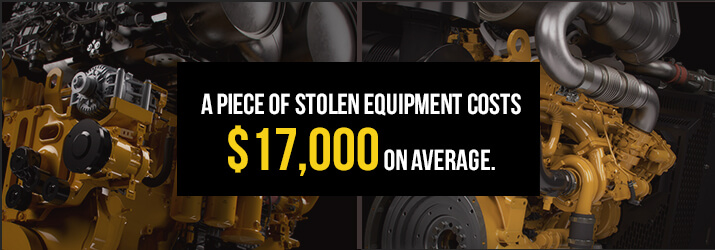
A piece of stolen equipment costs $17,000 on average. But the individual costs go beyond that number. When equipment gets stolen, you need to file insurance claims and police reports — actions that take plenty of time and effort. And once the insurance claim is filed, premiums are likely to rise. Missing equipment also results in lower productivity and schedule delays. These factors all lower the profit your business can make.
Who Covers the Expenses?
Theft of rental equipment costs both the renter and the dealership. Renters are generally expected to cover the cost of stolen equipment. Some of them get rental insurance to cover the price of an emergency like theft. But even if a renter has insurance and files a claim, the settlement may not pan out as expected from the rental contract. Filing such a claim also has a good chance of raising future insurance costs.
Meanwhile, the dealership has to account for a missing asset and help in the investigation process. If they don’t receive the full price of the rental from the renter or insurance company, they have to take it as a loss. They also have to put the time and effort into purchasing, transporting and preparing a replacement.
What to Do If Your Rental Goes Missing
Even the most careful renters experience equipment theft, so everyone should understand what to do when rented equipment disappears. Follow these steps when you suspect someone stole your equipment rental:
- Report the incident to authorities as soon as possible. The sooner you notify the law, the easier it is to recover the equipment. If you discover the theft on a Monday, reporting becomes even more urgent because you don’t know the exact day it was stolen. The person who reports the incident should have a good understanding of the equipment and its location before the theft. You will receive a report number to use for insurance claims and equipment recovery.
- Notify the rental dealership shortly after reporting the theft and let them know you made a report. They can help with the investigation process and insurance claims.
- File an insurance claim with the company that provides your renter’s insurance or negotiate the next steps with your dealership. This part of the process will depend on your coverage, the dealership’s coverage and the nature of the insurance.
If rental equipment theft happens to you, remember you still have a chance of the police recovering it. By communicating with the right people as soon as you can, you’re taking a proactive step toward getting the equipment back.
Preventing Equipment Theft
As you can see, rental equipment robbery costs you money and time and takes an extensive process to manage. Putting measures in place that make your worksite safe and discourage thieves will lower your risk of dealing with it in the first place. The next half of this guide will contain security tips that can apply to renters with various budgets. Even if you can’t afford many common theft prevention strategies, not all of them cost a significant amount of time or money. We’ll cover protection in all areas of work, including:
- The jobsite
- Your staff members
- The equipment
- Security devices
- Insurance coverage
Creating a Secure Worksite
A jobsite without security measures makes it easy for thieves to steal your rental machinery. If you have the means and clearance, increasing your worksite protection not only keeps your rentals safe, but it also reduces your risk of theft in general. Consider these ways to protect your jobsite:
- Install lights: Security lights and light towers illuminate your worksite at night when thieves have the biggest opportunity. Increased visibility at all times of day will make your area look less appealing to anyone thinking of taking equipment. After all, they could be easily seen while trying to steal your rental.
- Use see-through fencing: Using the same logic as for the lights, a chain-link fence or another type of see-through fencing can also keep thieves away by improving the visibility of anything that happens when you aren’t on the job.
- Create a single exit and entrance: Having only one gate to manage means fewer locks to keep track of when closing up at the end of the day. You will also know exactly where a successful thief exited your worksite, giving you helpful insight during the investigation.
- Hire guards or request a police patrol: Whether paying for a full night shift or simply asking someone to keep an eye on your site from time to time, consider off-hour security. They can discourage thieves and report an incident faster than if you noticed it when you got back on the job. If you work in an area with a high rate of equipment theft, you may be able to request increased police patrols near your worksite.
- Post warning signs: Signs with messages such as “no trespassing” or “24-hour patrols in this area” give criminals a clear warning. To really make a point, you could outline what laws would be broken and the resulting penalties that would apply.
- Practice basic data security: Keeping detailed digital records can help you react appropriately to theft, but it can also give criminals vital information if you don’t keep them safe. If your worksite has a computer, secure it to its desk and look into basic cyber security methods.
- Keep track of your keys: Create a key check-in/check-out where employees can borrow and return keys. Maintain a sign-out log and record who has access to every key used at your worksite. If something goes missing, you can immediately check your sign-out sheet and check-in area to see if a misplaced key is responsible.
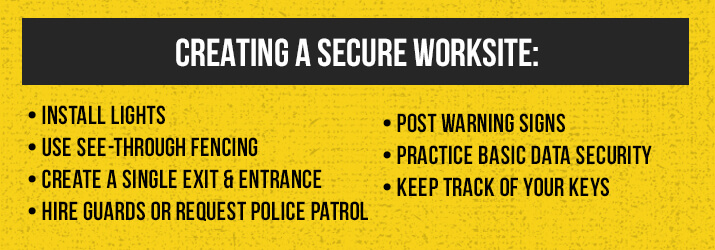
Training a Security-Savvy Team
You and your employees have much more control over equipment safety than you may think. Teaching staff how to keep equipment and worksite materials secure will greatly improve your chance of discouraging theft. Make your employees part of the solution by using these strategies:
- Make security an employee policy: Include clear security rules and procedures in your employee handbook so they understand how to spot and report potential thieves. Every now and then, conduct an unannounced site inspection to see if your staff practices these measures on a regular basis.
- Provide frequent training: Post security facts on an employee bulletin board or include them in training newsletters. Ensure everyone knows what to do to keep equipment in check by hosting regular training sessions on the subject. When you combine these meetings with written policies, you can help learners of all kinds remember what to do.
- Stay updated on criminal trends: Let your staff know if the rate of equipment theft in your area rises suddenly and give them a quick refresher of basic security procedures. During these times, consider conducting more security audits or putting other extra measures in place.
- Create a clear reporting protocol: If one of your employees is the first to notice missing machinery, you want them to know how to react fast. Make an easy-to-access, step-by-step document outlining everything they should do if something happens so you can report it as soon as possible.
- Have a place for everything: Every part of your worksite, whether big or small, should have an official storage area. Lock everything away in its proper place at the end of the day and keep a list of each item’s spot. This strategy will also make your work more organized and efficient.
- Include security in the job description: To ensure your employees do every security-related task expected of them, set aside some time during the day for them to do it. This practice makes anti-crime measures truly feel like part of the job instead of something tacked on. It also gives your employees the time to do every step the right way.
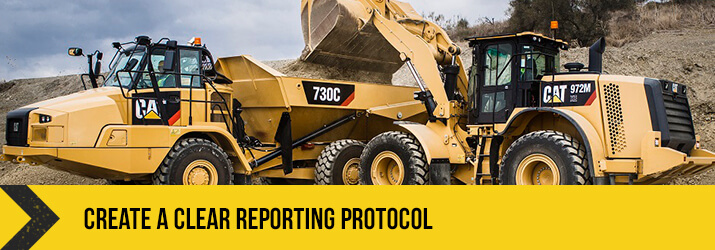
Protecting Your Equipment
Once your worksite and workers can better prevent equipment theft, you can focus on the machinery itself. Taking a few simple steps when handling your rental makes it less accessible to thieves. Create these habits to safeguard your equipment:
- Understand top targets: Some types of equipment are more prone to theft than others. Smaller or more mobile pieces, such as skid steers, backhoes and tractors, have the highest numbers of robbery. While you should do the most you can to keep all your machinery safe, these pieces should get extra attention.
- Move equipment to a safer area during off-hours: If you can’t set up a secure worksite, you could instead move your rentals to a safe storage area during nights and weekends. You should look into this option especially if your worksite doesn’t have a fence and gate.
- Surround smaller equipment with larger pieces: Anything that someone can easily move or carry should be surrounded by harder-to-move machines at the end of the day. Park everything in a circle with smaller equipment in the center. An intruder would have to deal with the larger machines in addition to their target, and that alone could discourage them from even trying.
- Disable your machines before you leave: A thief can’t drive your equipment if it doesn’t have the necessary parts. Something as simple as removing tires or batteries at the end of the day can effectively thwart criminal efforts. This method could take more time and effort in certain cases, but it also costs no money and ensures top protection.
- Remove power tools and small equipment: When you pack up for the day, take a look at your worksite through the eyes of a criminal. Does your team leave power tools or another type of small equipment out where an intruder could use them? Don’t keep out anything that someone could use to break into your rental. Instead, place it in a locked storage area where you know nobody can access it.
- Secure your rental during transport: When moving your equipment, use strong, high-quality kingpin locks and trailer hitches. Avoid overnight stops if possible and keep only a small amount of fuel in each piece. Keep keys out of the ignition and somewhere secure instead. Just like you would on the worksite, do whatever you can to make it difficult for thieves to easily move your equipment.
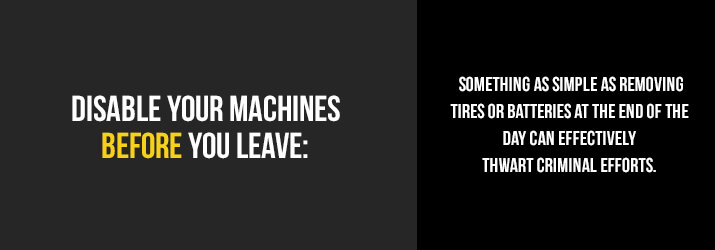
Theft-Deterrent Technology for Construction Equipment and Other Rentals
Technological developments have given us more security options than ever. If you can afford a crime-deterrent device for your worksite or equipment, it can make the investment completely worth it. Join the technology wave with the following devices:
- Install visible security cameras: Security cameras don’t just protect your premises by seeing people. They also keep your worksite safe by letting people see them. Visible security cameras send the message that you can and will track down any thieves caught on video. If someone does steal one of your rentals, you can use the footage as evidence to raise your chance of recovery.
- Geo-fencing: When you use geo-fencing, you create a digital “fence” around an area that detects when equipment travels outside it. When machinery is operated outside of the area, you can set the geo-fencing technology to shut it down. You can also use it after-hours to get notified immediately when equipment leaves the site.
- GPS tracking: If you can’t afford geo-fencing, you could also consider GPS devices that will give you real-time information on your equipment’s location. Keep an eye on it during off-hours or check it in case of a theft to understand where your rental is without even having to visit the site. A GPS device will help police track down the thief and reclaim your rental.
- Motion sensors: Certain devices can detect motion in the nearby area and trigger an alarm when it senses movement. Turn them on before you leave to scare off anyone who tries to enter your worksite or invest in a model that sends you a direct notification. Motion-sensing alarms come in a wide variety of models that suit your requirements.
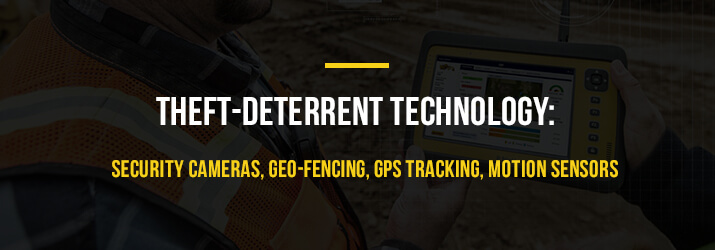
Renting Equipment With Security Technology
You can increase your equipment’s safety even when you rent it. More manufacturers are installing theft-deterrent tech in their machines to fight the high rate of equipment robbery. Some models have geo-fencing and GPS technology already built-in. Others have keyless ignitions that prevent hotwiring and need a PIN to operate. Before you pick a model to rent, ask the dealership if they have any newer models with these kinds of features. They may be more costly to rent, but they provide a peace of mind you can’t beat.
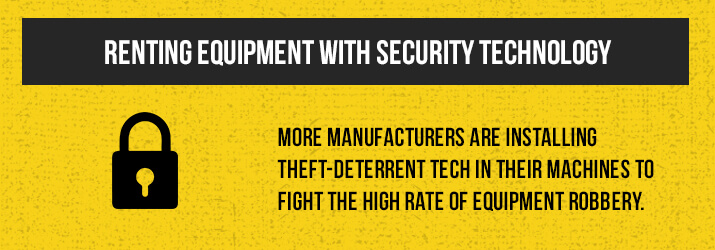
Investing in Rental Equipment Insurance
Robberies can happen to even the most careful companies. Even if you follow most of the above tips, you still want a backup plan if a rental disappears. Certain types of insurance will cover stolen rental equipment, so you don’t have to. You should consult an insurance agent for the exact details, but these coverages could apply:
- Commercial auto: In addition to company-owned cars, some types of commercial auto insurance cover rental vehicles. Whether it will cover the machinery you rent will depend on the policy.
- Inland marine: This kind of insurance can cover all sorts of physical damage to property. Its flexibility lets you request coverage of rental equipment when other policies can’t include it.
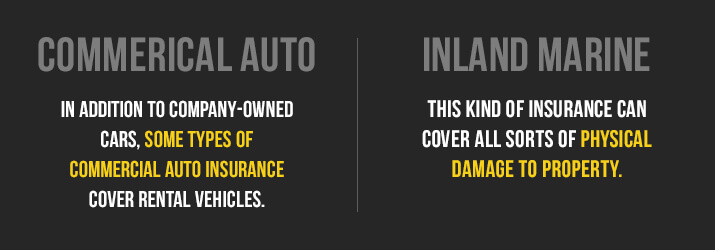
Many dealerships already require renters to have basic liability coverage as well as insurance for the type of equipment they’re renting. Talk to your rental company and insurance agent to determine if you could use more coverage in the event of a theft.
Find Our More About Protecting Your Rentals From MacAllister Rentals
At MacAllister Rentals, we want to offer our customers so much more than equipment. While we keep our rentals in top condition, we also want to give you solutions that help you get the job done. That’s why we write guides like this one that help our customers understand how to get the most out of their rentals. For more advice and information, check out our other resource guides. Feel free to reach out to us today if you have any questions.
